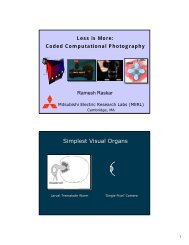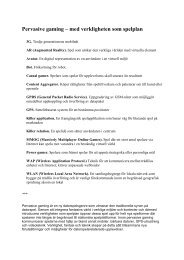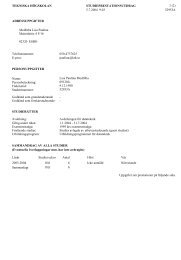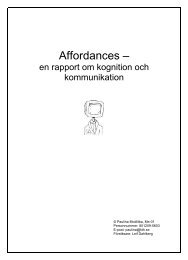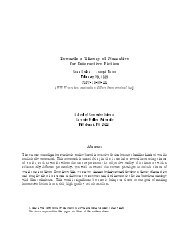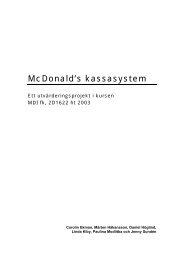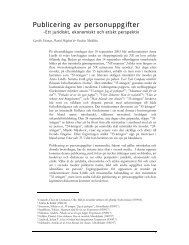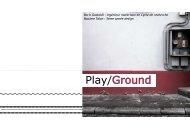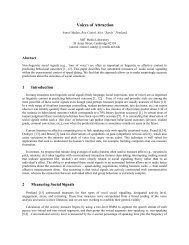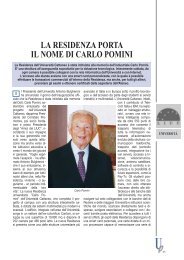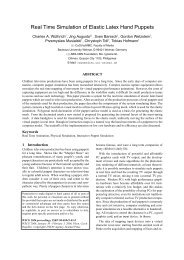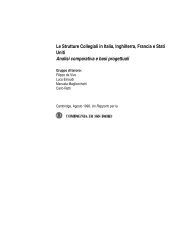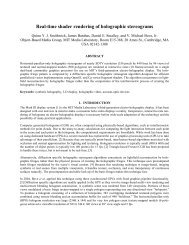Getting Hands-On with Soft Circuits - MIT Media Lab
Getting Hands-On with Soft Circuits - MIT Media Lab
Getting Hands-On with Soft Circuits - MIT Media Lab
You also want an ePaper? Increase the reach of your titles
YUMPU automatically turns print PDFs into web optimized ePapers that Google loves.
3. Explain.that.a.circuit.is.a.continuous.loop.<br />
through.which.electricity.can.travel ..Our.<br />
circuits.all.have.a.power.source,.and.for.<br />
our.purposes.this.will.be.a.coin.cell.battery ..<br />
Additionally,.circuits.can.have.outputs,.such.<br />
as.lights.and.motors ..As.we.design.a.circuit,.<br />
our.goal.is.to.guide.the.electricity.out.of.the.<br />
battery,.through.any.output.components.<br />
(like.lights),.and.then.back.to.the.battery .<br />
4. Point.out.that.batteries.and.LEDs.have.a.<br />
“positive”.and.a.“negative”.side ..This.is.called.<br />
polarity..<br />
•..Positive.is.also.referred.to.as.+,.power,.or.by.<br />
using.the.color.red ..The.positive.side.of.an.<br />
LED.is.known.as.an.anode and.corresponds.<br />
to.the.longer.metal.leg .<br />
•..Negative.is.also.referred.to.as.-,.ground,.<br />
or.by.using.the.color.black ..The.negative.<br />
side.of.an.LED.is.known.as.a.cathode and.<br />
corresponds.to.the.shorter.metal.leg .<br />
5. Explain.that.connections.should.be.made.<br />
from.positive-to-positive.and.negative-tonegative<br />
..Positive.and.negative.connections.<br />
should.never.touch.or.cross.-.this.will.cause.a.<br />
short circuit (which.won’t.be.functional) .<br />
6. Ask.students.to.sketch.the.electrical.<br />
connections.and.placement.of.components.<br />
for.their.first.project ..This.may.look.similar.<br />
to.the.example.schematic,.or.it.can.vary.(for.<br />
example,.the.electrical.connections.might.<br />
zigzag.or.follow.a.decorative.path) ..<br />
7. Distribute.one.of.the.following.to.each.<br />
student:.battery,.battery.holder,.LED.(light),.<br />
felt.piece ..Make.the.rest.of.the.materials.<br />
available.on.a.common.table .<br />
8. Ask.students.to.pair.up.and.compare.LEDs,.<br />
identifying.the anode.and.cathode .<br />
9. Instruct.students.to.curl.the.legs.of.their.<br />
LEDs.using.the.needle.nose.pliers.so.that.the.<br />
LEDs.can.be.sewn.to.fabric ..(See.photo.at.<br />
right.for.an.example .)<br />
10. Have.students.transfer.their.sketched.circuit.<br />
design.onto.their.piece.of.felt.by.using.chalk ..<br />
(The.chalk.will.wash.or.rub.off.after.the.<br />
project.is.complete .)<br />
5<br />
11. Suggest.that.students.attach.the.<br />
components.to.their.fabric.<strong>with</strong>.a.dab.of.<br />
hot.glue,.being.careful.leave.the.conductive.<br />
parts.of.the.components.exposed ..<br />
12. Students.can.follow.the.chalk.pattern.to.sew.<br />
the.connections.between.components.and.<br />
sew.the.components.to.the.fabric ..Make.sure.<br />
they.sew.each.component.securely.to.the.<br />
fabric.(similar.to.sewing.on.a.button).before.<br />
sewing.between.components ..After.sewing.<br />
each.connection,.students.should.tie.a.knot.<br />
on.the.fabric’s.backside.and.cut.the.thread .<br />
13. After.students.have.finished.sewing,.show.<br />
them.how.to.insert.the.battery.into.the.<br />
battery.holder.(<strong>with</strong>.the.“+”.side.facing.up) .<br />
Tips for Working <strong>with</strong><br />
Conductive Thread<br />
•.Try.to.keep.your.stitches.as.close.together.as.<br />
possible.-.this.will.keep.them.in.place.whenever.<br />
you.bend.or.pull.on.your.fabric .<br />
•.Conductive.thread.tends.to.fray,.so.if.a.circuit.is.<br />
not.functioning,.check.for.spots.where.the.thread.<br />
has.frayed.to.the.point.of.making.contact.<strong>with</strong>.<br />
another.electrical.connection.of.opposite.polarity .<br />
•.Because.the.thread.frays.easily,.it.may.be.difficult.<br />
to.thread.your.sewing.needle ..Run.thread.through.<br />
beeswax.or.use.needle.threaders.to.help.<strong>with</strong>.this .<br />
•.Knots.that.are.tied.<strong>with</strong>.conductive.thread.may.<br />
not.stay.in.place.permanently.on.their.own ..<br />
Secure.each.of.your.knots.by.dabbing.them.<strong>with</strong>.<br />
hot.glue ..This.will.also.help.insulate.any.loose.<br />
thread.ends .<br />
•.The.soft.circuits.created.in.these.activities.are.<br />
washable!.Just.remove.the.battery.and.hand-wash.<br />
<strong>with</strong>.gentle.detergent .<br />
a sewable LED whose legs<br />
have been curled <strong>with</strong><br />
needle nose pliers



